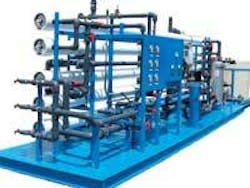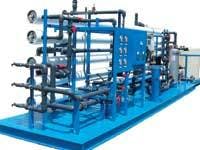Reverse Osmosis System Tackles Hard Water Problems
Douglas County is the fifth largest county in Kansas, with a population of approximately 103,000, all depending on their water district for safe, clean water. Douglas County Rural Water District #3 strives for consistent, high quality water and to maintain consumer satisfaction. The completion of upgrades, including a reverse osmosis system for softening to its Big Springs Water Treatment Plant, is part of that initiative. The district’s service area is 100 square miles split between two counties, with 1,700 metered customers, two wholesale connections and 200 miles of distribution piping.
The Big Springs plant was the foundation of the district with its two shallow wells. As the number of connections grew, and with it the district, water was purchased from nearby Topeka to supplement the well supply. In 1983 the Tri-District Surface Water Treatment plant went on-line, augmenting the other sources. The district shares this source’s production of 2.5 million gallons per day with two other rural water districts.
The wells at the Big Springs facility are used to help meet peak demand during summer. A cold lime softener was used for iron and manganese removal for 25 years. It worked well when the treatment devices would cooperate, but hiccups in lime feed led directly to red water complaints from the consumers. Due to the age, high operating costs, and sludge production of the lime softener, the district replaced it with a Filtronics Electromedia I filter plant in 1996.
Soon after the new plant went into service, consumers noticed the difference. Scaling showed up on plumbing fixtures and in coffee makers. With surface water at one source and softened water at the other, hardness had never been an issue. Although the hardness levels were not in violation of Kansas Department of Health and Environment (KDHE) standards, the district decided something had to be done to maintain customer satisfaction. To reduce the hardness, they went forward with softening.
After a competitive bid process, Filtronics was chosen as the supplier of the softening system using reverse osmosis (RO). A membrane skid was installed in a newly constructed addition at the Big Springs Water Treatment plant.
The controls for the reverse osmosis skid were integrated into the existing programmable logic controller and graphic display panel for the filter system. The telemetry system was updated also to include operational information and system alarms for the RO equipment.
The raw water iron and manganese levels are 8.0 and 2.0 mg/L, respectively, with both consistently reduced to less than 0.015 mg/L. The filtered water is discharged to a holding tank in front of the reverse osmosis system, with the overflow providing blending with the RO permeate to a finished water clear well. Thirty one percent of the final product water comes from the blend line to provide calcium and alkalinity. This avoids corrosion control issues in the distribution system.
In the event the RO is offline, the overflow water from the iron and manganese pretreatment filters goes to the finished water clear well, allowing the district to produce water. The operation of the plant continues automatically via the telemetry and local plant controls.
With the integrated iron, manganese, and softening treatment systems in place, the finished water has a hardness level of 120 mg/L, down from a raw water level of about 350 mg/L. (The Tri-District Surface Water Source has 140 mg/L hardness.) The total dissolved solids are reduced from 620 mg/L to less than 180 mg/L.
Bruce Smith, Manager of Douglas Rural Water County #3 said: “Although we have used this supply for many years, we have never fully utilized its potential. I expect to change that, immediately.”
The Big Springs Well field is the only supply that may be expanded to meet the expected growth rate of 2% per year. Smith also stated: “I am very excited to have this new facility in operation and look forward to tracking the costs and operational aspects of this process.”

